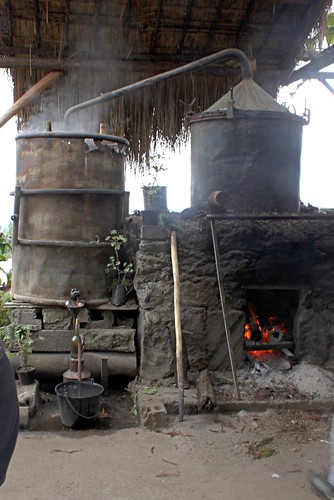The Maïdo (2203m) is probably one of Reunion's most visited tourist sites (although that's entirely relative - there's never much of a crowd). It's also part of Reunion's UNESCO site "Pitons, Cirques and Remparts".
Part of the commune of Saint Paul, it affords a bird's eye view over the whole cirque (natural amphitheatre) of Mafate, which is only accessible by foot or helicopter.
So if you're not into into hiking, are too broke for the helicopter ride, or just want to look at Mafate before or after hiking there, this is the place to go.
So if you're not into into hiking, are too broke for the helicopter ride, or just want to look at Mafate before or after hiking there, this is the place to go.
Looking to escape the January heat we first headed up to Petite France, a village at 1100m, where the relative of a family member has a piece of land we camped on.
| bee hives |
As the land used to be lived on, there are a number of plants that have been planted, others grow wild.
| Agapanthus ("Lily of the Nile") |
| Tamarillo (tree tomato) |
| Montbretia |
| Nasturtium |
| peaches |
The next morning we drove the remaining 1000m uphill to Piton Maido itself. There are many alembics (stills) in this area, used for distilling essential oils, mainly geranium.
 |
| an alembic (photo source) |
The further you drive up the sparser the vegetation becomes.
In late October 2011 the Maïdo suffered a bad fire when 3000 ha burnt.
Once you arrive at the view point you need to hope there are no clouds to obscure the view. To be sure of this it's often best to go early in the morning, but you can still go later in the day and be lucky.
When you look to your right (south-east) you can see the 3 Salazes and the Col de Taibit which is a pass between Mafate and the cirque of Cilaos. At the foot of the Col de Taibit (Mafate side) lies the ilet (or hamlet) of Marla, at 1600m.
| Marla is Mafate's highest hamlet |
Looking directly right (south) you can see the Grand Benare (2898m).
| Grand Benare is Reunion's 3rd highest peak |
When you look straight ahead (east) you have the Gros Morne (3019m) directly in front of you.
As it is almost as high as the Piton des Neiges (3070m) the latter is hidden from view from most angles.
The village in front of the Gros Morne from this line of view is La Nouvelle, Mafate's largest village.
| La Nouvelle |
Looking to the left of the Gros Morne (north east) you can see the hamlet of Roche Plate.
| Roche Plate |
Looking left (towards the north) you can see the distinctive, knife-edged Crête des Orangers (1300m). The buildings behind it to its left are the hamlet of Ilet des Orangers, and those on a plateau on the right of the photo are the hamlet of Grande Place.
Although this was a place I'd often been to before, it was the first time we'd been back since we spent 3 years in Korea.
After admiring the view we headed back down, stopping at another family member's piece of land at 1300m for a picnic lunch.
We saw some interesting wild mushrooms there.
| Lucky clover (oxalis tetraphylla) |
This bramble is a climbing shrub introduced to Reunion that has an unfortunate tendency to smother local vegetation. Programmes are underway to try and eradicate it. It's known locally as vigne marron.
| Giant bramble (rubus alceifolius) |
| Mock strawberry (potentilla indica) |







